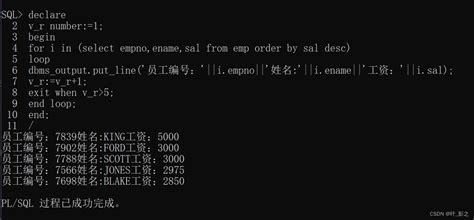您所在的位置:首页 - 科普 - 正文科普
plsql编程题
![]() 方祥
2024-05-13
【科普】
869人已围观
方祥
2024-05-13
【科普】
869人已围观
摘要**Title:MasteringPL/SQLCursorProgrammingforEfficientDatabaseOperations**PL/SQLcursorsareessentialcom
Title: Mastering PL/SQL Cursor Programming for Efficient Database Operations
PL/SQL cursors are essential components for database operations, enabling developers to iterate through result sets returned by SQL queries. Cursors provide a powerful mechani*** for data manipulation and retrieval within PL/SQL programs.
There are two primary types of cursors in PL/SQL: implicit and explicit cursors.
1. Implicit Cursors
Implicit cursors are automatically created by Oracle when a SQL statement is executed within PL/SQL code. These cursors are suitable for simple queries that return a single row or value.
2. Explicit Cursors
Explicit cursors are declared and managed by developers within PL/SQL code. They provide more control and flexibility, especially for complex queries and result sets.
PL/SQL cursors come with a set of attributes and functions to facilitate efficient data processing.
1. %ROWCOUNT
This attribute returns the number of rows affected by the most recent DML statement.
2. %FOUND and %NOTFOUND
These attributes determine whether a cursor has retrieved any rows (%FOUND) or not (%NOTFOUND).
3. %ISOPEN
It indicates whether a cursor is open (%ISOPEN) or closed.

4. CURSOR_NAME%ROWTYPE
Using this attribute, you can define a record variable that represents a row in the cursor result set.
To optimize performance and maintainability, adhere to the following best practices when working with PL/SQL cursors:
1. Use Bulk Operations
Whenever possible, utilize bulk operations (BULK COLLECT and FORALL) to minimize context switches between PL/SQL and SQL engines.
2. Limit the Use of Cursors
Avoid unnecessary cursor declarations within loops. Instead, aim to accomplish tasks with setbased operations.
3. Close Cursors Explicitly
Always close cursors explicitly once you're done using them to release database resources promptly.
4. Handle Exceptions Gracefully
Implement proper error handling mechani***s, including exception handling within cursor loops, to ensure robustness and reliability.
5. Optimize Query Performance
Optimize SQL queries used within cursors by creating appropriate indexes and ensuring efficient query execution plans.
Below is an example demonstrating the usage of an explicit cursor:
DECLARE
CURSOR c_employee IS
SELECT employee_id, first_name, last_name FROM employees;
v_employee_id employees.employee_id%TYPE;
v_first_name employees.first_name%TYPE;
v_last_name employees.last_name%TYPE;
BEGIN
OPEN c_employee;
LOOP
FETCH c_employee INTO v_employee_id, v_first_name, v_last_name;
EXIT WHEN c_employee%NOTFOUND;
Process the retrieved data
DBMS_OUTPUT.PUT_LINE('Employee ID: ' || v_employee_id || ', Name: ' || v_first_name || ' ' || v_last_name);
END LOOP;
CLOSE c_employee;
END;
PL/SQL cursors are indispensable tools for database programming in Oracle environments. By mastering cursor programming techniques and adhering to best practices, developers can enhance the efficiency, performance, and maintainability of their PL/SQL codebase.
Tags: plsql编程语言 plsql编程题 plsql编程基础赋值与初始化 plsql编程100例
版权声明: 免责声明:本网站部分内容由用户自行上传,若侵犯了您的权益,请联系我们处理,谢谢!联系QQ:2760375052
上一篇: 江门数控编程哪里学好一点
下一篇: 编程接口类型
最近发表
- 探索日本核污染水排放,现状、影响与应对策略
- 全职妈妈离婚获2万元经济补偿,揭秘背后的真相与启示
- 王琳惊艳亮相,54岁穿短裙婚纱走秀的优雅与活力
- 继续深耕中国,共创共享机遇
- 千位歌迷在刀郎演唱会现场外,音乐盛宴如梦如幻
- 渔船遇海盗袭击,3名中国人失踪,紧急救援与深入理解
- 小米试驾体验遇尴尬,雷军秒道歉引热议
- 香港歌手李国祥去世
- 音乐人因刀郎跨越西洋乐与中国音乐的奇妙转变——深度解读与启示
- 清华毕业生失踪背后的罗生门,揭开真相与寻找答案
- 韩国救山火消防员盒饭,一份充满人间温情的瞬间
- 黄金价格的终极目标,探寻价值与投资方向
- 小区惊魂,儿童车祸事故的警示与启示
- 湖南38个机关事业单位围墙全拆,开启新篇章
- 车主掉头遇红灯,后车滴滴巧应对
- 探索云南曲靖市会泽县的地震事件
- 新郎没拉裤子拉链,新娘手动闭链的浪漫婚礼
- 10岁女孩高烧去世,被诊断为7种疾病
- 拥抱与冒险,两个小孩的温馨瞬间与泥坑的奇妙旅程
- 女厅官落马后,下属被查风波掀起波澜
- 勇敢逆行,诠释人间大爱——关于溺亡外卖员及其家庭的故事
- 大摩小摩去年四季度疯狂买A股
- 从人去楼空歌词中读懂离别的深情与生命的哲思
- 甲亢患者学功夫之路,挑战与成长
- 九牛一毛歇后语——生活中的小智慧大道理
- 多名大陆配偶被限期离台 台各界发声
- 和巧虎一起玩躲猫猫,让孩子在游戏中学习与成长!
- 王者荣耀游戏体验优化与应对关键问题的应对策略
- 探索趣味与成长的数字乐园
- 地震的力量,缅甸与汶川地震的对比
- 畅享军事模拟游戏的无限乐趣
- 缅甸地震,灾难中的救援与应对
- 董宇辉报平安,温馨时刻
- 机战王洛洛历险记全集——一场童年的奇幻冒险之旅
- 揭开美军飞行员之怒,深入了解行为后果与安全责任
- 揭开全国重名查询系统的神秘面纱,如何轻松找到与你同名的人
- 缅甸地震中的救援行动与启示
- 揭秘你的另一个星座,探索隐藏的性格密码
- 东旭集团证券违法拟被罚17亿元
- 深入解析暗黑破坏神攻略,助你成为圣休亚瑞的传奇英雄
- 专家解读地球是否进入活跃期文章标题
- 畅玩经典——实况足球10中文版的全面解析与攻略
- 牛肉市场中的中方与美国厂商,续约与挑战
- 畅玩捕鱼达人单机版,轻松体验水下冒险的乐趣
- 王钰栋应对脚踝受伤,回应与处理
- 探索自然的灯塔——野外女教师的角色与魅力
- 华阳集团,2024年净利润增长引领行业新篇章
- 探索南美大陆的地理瑰宝
- 男子做马拉松陪跑一场收入6000元
- 69岁阿姨的退休生活,自驾游的传奇之旅文章标题及内容


